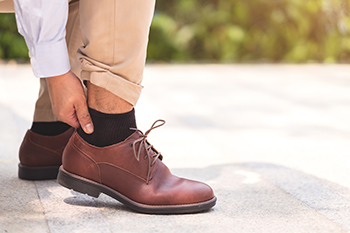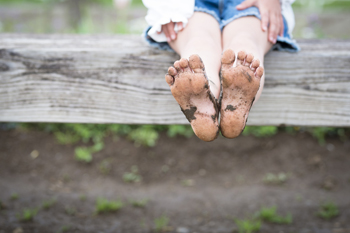Items filtered by date: April 2023
Causes of Tingling Toe Pain

If your toes are tingling, but also painful, it may be a sign of a more serious condition in the circulatory or nervous system. For that reason, it makes sense to take action quickly rather than ignore these sensations as a minor inconvenience. Tingling in the toes may be caused by standing or sitting for long periods, especially in high heels or tight-fitting shoes that effectively block blood circulation to the feet. Another common cause of tingling toes is diabetes, which can damage the blood vessels that send nourishing blood to the extremities. This can set off a chain reaction that causes damage to the nerves themselves. If ignored, the result can be increased numbness, along with the painful tingling of the toes, and may eventually involve the entire foot. Other conditions, including multiple sclerosis, Raynaud’s disease, and vitamin B deficiency, can also result in tingling toes. If you are experiencing this condition, it is suggested that you make an appointment with a chiropodist as soon as possible for a full examination and diagnosis.
Toe pain is common and can have a variety of causes. Causes can range from a broken toe to an ingrown toenail. Many types of toe pain can be corrected, but any toe pain that inhibits your activities for an extended period should be discussed with a chiropodist. If you suffer from toe pain, please consult with one of the chiropodists from Complete Family Footcare & Therapy. Our clinicians can help you maintain the health of your feet.
Common Causes of Toe Pain
- Trauma or fracture
- Cuts, sores, or bruises
- Rheumatoid arthritis
- Gout
- Turf Toe
- Morton’s neuroma
- Blisters
- Corns
- Bunions
- Hammertoes
- Ingrown toenails
- Plantar warts
- Athlete’s Foot
Symptoms of Toe Pain
- Toe deformity
- Burning
- Numbness
- Toenail deformity
- Wart or ulcer
- Swelling
- Redness
When to See a Chiropodist
- Bleeding or severe swelling
- Trauma, such as a broken bone
- Discoloration or extreme swelling
- Inability to bear weight
- Persistent pain
- Wounds that won’t heal
Diagnosis of Toe Pain
A chiropodist can conduct a thorough examination of the painful toe or toes in order to determine the best course of treatment. The exam may include assessing the tenderness of the area, taking an X-ray or other diagnostic test, or assessing your gait and range of motion. A discussion of what led to the advanced pain issue may follow. Included will likely be a health history, as well as a list of medications you are taking and other previous injuries you may have sustained.
Treatment for Toe Pain
With such a wide range of possible causes for toe pain, treatment can be varied in scope and length. Sometimes, the chiropodist will recommend lifestyle and activity changes. In cases of trauma or other injuries, X-rays or imaging tests will likely be used to determine the severity of the problem, particularly if any bones have been broken. Treatment may also include injections of pain-relief medication or anti-inflammatory drugs. Certain injuries will require the splinting, bracing, or wrapping of injured toes. Orthotics or special shoes may be prescribed in cases of bone deformities and gait issues. Removal of warts, calluses, and corns may be needed. In other cases, such as with patients who have diabetes or rheumatoid arthritis, ongoing treatment may be required to avoid more serious problems.
What You Can Do if You Work on Your Feet All Day

Lower limb disorders are common among those who work on their feet all day, and some form of foot pain is almost inevitable in this population. Some of the pain can be alleviated by wearing the right shoes for the job performed, as well as following a daily foot care routine. Those who work on their feet include chefs, hair stylists, and retail store workers. For those who stand on their feet for prolonged time periods, it is recommended that shoes have at least a quarter-inch heel, good arch support, and fit well. Wearing shoes that are too tight significantly increases the chances of foot pain. It is beneficial for shoes to be purchased later in the day when feet are at their largest. If one foot is longer than the other, the larger foot should dominate in shoe size. When at work, it is helpful to take frequent breaks to stretch painful and stiff muscles. When at home, feet can be elevated and massaged. If pain persists, it is suggested that you visit a chiropodist who can give you additional tips on how to perform your job more comfortably.
If you stand all day, you may be at an increased risk of developing various foot conditions. If you are experiencing foot pain of any kind, please consult with one of the chiropodists from Complete Family Footcare & Therapy. Our clinicians will assess your condition and provide you with quality foot and ankle treatment.
What Foot Problems Are Caused by Standing?
Standing all day at work may increase your risk of developing foot or ankle problems.
Some common foot conditions that may arise from spending all day on your feet include:
-
Foot pain
-
Blisters
-
Corns and calluses
-
Arthritis
-
Flat feet
-
Bunions
-
Sprains
-
Athlete’s foot
Prevention
If you stand for prolonged periods of time for work, taking preventative measures to preserve the health of your feet is strongly recommended.
Measures you can implement to help prevent foot problems include:
-
Wearing shoes that are comfortable and fit well - these shoes should be made of breathable materials and provide you with arch support and cushioning. It is best to avoid shoes that have heels or narrow toe boxes.
-
Taking breaks to rest, walk, and stretch your feet throughout the day
-
Maintaining good foot hygiene - wash and dry your feet thoroughly every day
If you have any questions, please feel free to contact our offices located in . We offer the newest diagnostic and treatment technologies for all your foot care needs.
Happy, Healthy Feet Contribute to a Happy, Healthy Life

We often neglect to care for our feet and instead take them for granted. Unless they hurt us, we forget all our feet do for us. This is true despite chronic foot problems impacting all other parts of our lives. There are easy things we can do to care for our feet and ensure foot health throughout our lives. Some simple foot care tips include wearing properly fitting shoes, washing, drying, and moisturizing the feet daily, and cutting nails straight across. Feet should be measured regularly and especially if you plan to buy a new pair of shoes. If one foot is larger than the other, opt for the shoe size that fits the bigger foot. Shoes should not need a break-in period to become comfortable. They should be comfortable from the get-go. If you have a desire to best care for our feet, consult with a chiropodist who can best guide you in this endeavor.
Caring for your feet is not just something done at the chiropodist’s office. Good foot care starts at home. If you would like to learn more about daily foot care practices, please consult with one of the chiropodists from Complete Family Footcare & Therapy. Our clinicians can help you maintain the health of your lower limbs and your mobility.
There are many things that you can do at home to help care for your feet, including:
-
Wearing shoes and socks that fit properly
-
Washing the feet daily with soap and water
-
Drying the feet thoroughly
-
Applying moisturizer to the soles and heels of the feet
-
Taking a walk and exercising the feet regularly
-
Doing foot stretches and strengthening exercises
A chiropodist can help figure out a manageable foot care routine for you to keep your feet healthy. If you have any questions, please feel free to contact our offices located in . We offer the newest diagnostic and treatment technologies for all your foot care needs.
Why Live with Pain and Numbness in Your Feet?
Foot Pain in Kids

If your child tells you or shows you that their feet hurt, they may be experiencing growing pains. Growing pains in children’s feet are more common in preschoolers and preteens and usually happen later in the day or at night. Experts believe such pain may develop from intense childhood activity, including running, jumping, and climbing. Overuse injuries are common in children involved in competitive sports and who train a lot. These injuries typically resolve with rest and time. However, if your child has foot pain that is prolonged and consistent and interferes with normal functioning, it may be a sign of something more serious. Because of this, it is suggested that you make an appointment with a chiropodist for a complete foot evaluation and any necessary treatment.
Foot pain can have many causes. To receive an accurate diagnosis and treatment for your foot pain, please consult with one of the chiropodists from Complete Family Footcare & Therapy. Our clinicians will assess your condition and provide you with quality foot and ankle treatment.
Causes
There are a variety of different conditions that can cause foot pain, including:
-
Plantar fasciitis
-
Deformities, such as bunions or hammertoes
-
Injuries to the muscles, bones, tendons, or ligaments in the feet
-
Arthritis
-
Flat feet
-
Ingrown toenails
Symptoms
The type and location of your foot pain can help determine what may be causing it and what type of treatment options are best for you.
Common types of foot pain include:
-
Heel pain
-
Arch pain
-
Toe pain
-
Ball of foot pain
-
Pain that has a stabbing, burning, or tingling quality
-
Pain that is constant, intermittent, or that gets better or worse depending on the situation
Diagnosis
A thorough medical history and physical examination of your feet will be required to determine a diagnosis. Imaging studies, such as X-rays or MRIs may be performed to rule out or confirm certain diagnoses.
Treatment
Treatment will depend on the cause of the pain. Common treatments for foot pain include resting, icing, compressing, and elevating the affected foot, wearing orthotics, or taking anti-inflammatory medications.
If you have any questions, please feel free to contact our offices located in . We offer the newest diagnostic and treatment technologies for all your foot care needs.

